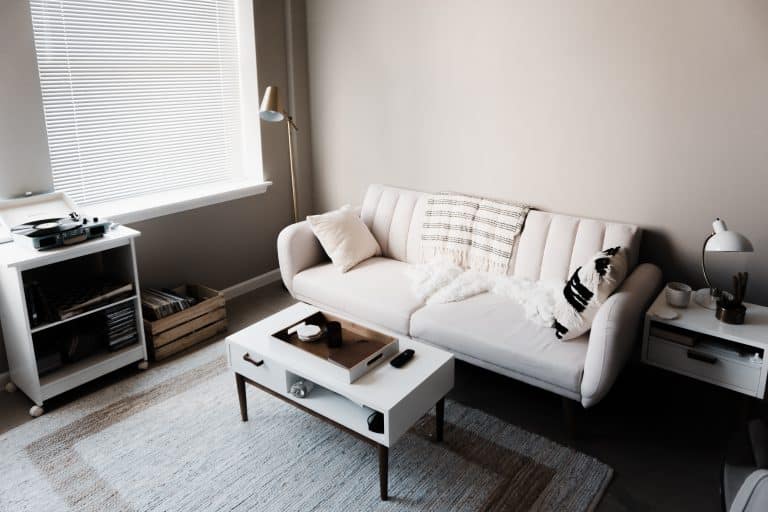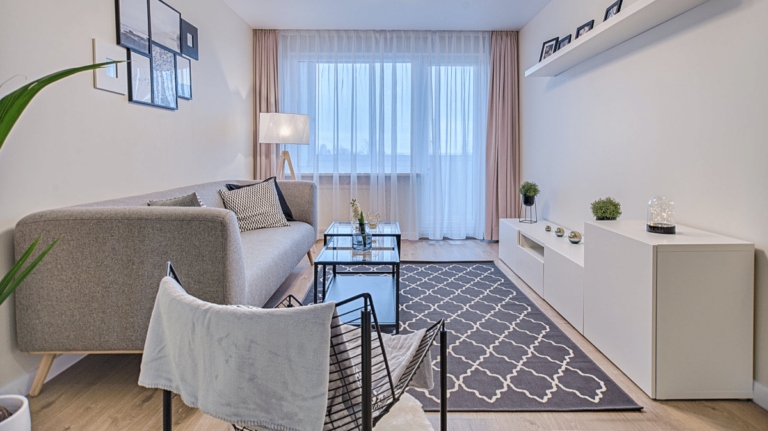House hunting can be fun, but it’s not always easy. From sorting out your personal finances to picking out paint colors, here’s our start-to-finish guide to finding the perfect home.
Step Up Your Savings, and Clean Up Your Credit

Would-be homeowners do not need to have 20% of the cost of their future home in savings to use as a down payment. If you want to buy a home, you will need to have some money saved up. But if a low down payment is the only way you can make home buying a reality, don’t sweat it. Mortgage insurance for buyers who put less than 20% down isn’t terribly expensive, and you won’t be required to pay it once you’ve built sufficient equity in your home.
You’ll likely incur expenses related to your new home even before you officially own it. There will be appraisers and inspectors and maybe attorneys to pay well before you’re finished with the home buying process. Make sure you’ve got the funds ready for those expenses along the way.
Some lenders have cash reserve requirements. It’s possible that your mortgage lender may want to see enough cash on hand to cover your housing expenses for several months, even after you’ve put in a down payment on your home.
Know your FICO credit score. The exact cut-off point varies by lender, but generally you’ll want a FICO credit score in the 700s or better to qualify for a mortgage. People with scores above 740 get the very best rates: anything below 620 and you’ll probably have trouble finding a lender.
Check your credit reports for errors. Dispute any errors with the credit reporting bureau immediately, and wait until your report has been fixed (and your credit score has been updated) before you apply for a mortgage.
Improve your credit score by paying down debt. If you can make some headway on your revolving debts before you apply for a mortgage, lowering your credit utilization should improve your credit score, which could mean a better mortgage interest rate.
Decide How Much House You Can Really Afford

Budgeting is important for any big financial decision, and there aren’t many financial decisions bigger than buying a home. Sticking to a budget when shopping for a home is critical.
Start by thinking about your current spending. How much you are paying for housing right now? How well does that work with your current goals and lifestyle? If your mortgage payment is likely to be more than you’re currently spending, make sure you’re prepared for the higher housing costs.
Consider financial sacrifices you might be willing to make to buy your own home, and what sacrifices would be too much. You might be willing to give up your daily latte habit, but unwilling to eat peanut butter sandwiches for dinner every day for the next thirty years. Keep these in mind when you’re tempted to stretch your budget upwards.
Calculate your debt-to-income ratio. Your debt-to-income ratio is as important as your credit score for determining whether you’ll be eligible for a mortgage. To get your debt-to-income ratio, divide your monthly required debt payments by your total income in a regular month.
If you make $6,000 a month before taxes, and you pay $300 a month on your student loans and $300 a month on your credit cards, then your current debt-to-income ratio would be 10%.
Mortgage lenders generally want to see a debt-to-income ratio below 43%, including the costs of your soon-to-be mortgage. In most cases, a borrower won’t be approved for a mortgage if her total debt payments each month would require more than 43% of her pre-tax income. Keep in mind, that payment amount needs to cover not just the principal and interest on her mortgage, but also property taxes, HOA fees, and insurance.
In our example, a person making $6,000 dollar each month with $600 a month in other debts could potentially pay up to about $1,980 each month for her mortgage payment.
The exact amount a person can borrow without exceeding the debt-to-income ratio limit is going to depend on down payment size and interest rates. Paying off some other debt before you buy a home can help you lower your debt-to-income ratio. There are lots of good online calculators where you can fiddle with the numbers.
Remember that you have to eat. Just because you could potentially borrow enough to owe 43% of your pre-tax income each month doesn’t mean that that’s how much you should borrow. For most people, 43% of their income going to debts is uncomfortably high. Leave room in your budget for savings, retirement, emergencies, and the occasional new pair of shoes.
Once you have a budget, stick to your budget. Before you hit the open houses, decide on a target home price for what you’d like to spend for a home, and know your absolute maximum home price. Buying more home than you can pay for comfortably puts you at risk for foreclosure. Even if you do manage to make ends meet, living with an overstretched budget can make you miserable for years on end.
Figure Out Your House-Hunting Priorities

Focus on what’s truly important. Before you get too carried away making lists of all the fun things you’d like to have in your home, stop and think about what home features are absolute-must-haves for you and your family.
Location – You may already have idea about what neighborhoods or towns you’re interested in. Are you looking for a community with good nightlife or a quiet peaceful retreat? Is walkability important to you? Think about proximity to schools, shopping, and recreation activities you enjoy, and don’t forget to factor in your potential commute.
Number of rooms – Consider the size of your family, and whether you expect to add to your family in the near future. The one-bedroom, one-bath condo might be just right for your and the spouse, but not right in a few years if you have children.
Size – Try to avoid getting hung up on exact square footage. Instead, think about your home needs in terms of useable space. Generally, a larger floorplan means higher utility bills and a bigger mortgage. Many American families live in homes with more rooms than they use daily. But even if you only use that formal dining room or dedicated workout space once in a blue moon, you’ll pay for it year-round.
Age and type of home – Do you want to live in a shiny, new condo? Or a charming Victorian farmhouse? Remember, old homes may have lots of character, but they often require more intense maintenance than newer homes: that beautiful 100-year-old exposed brick wall probably has 100-year-old plumbing just behind it.
Special features – Do you need room for your woodworking bench? Or a chef-ready kitchen for entertaining? Do you get sad without lots of natural light? By all means, make your favorite hobbies and activities a priority. Your home is where you’ll live your life, after all. Just be realistic about what you really need, and what would be nice but isn’t essential.
Work with your partner. If you’re not the only one who’ll be living in your new home, work with your spouse or partner to come up with your list of essentials for your new place.
Get Your Mortgage Application Together

Gather your financial documents. Mortgage lenders are going to ask you for documentation related to your income, your assets, and your debts. As soon as you’re ready to start looking for a home, start putting your mortgage application together.
‘Pre-qualification’ doesn’t mean much. In the mortgage world, ‘pre-qualification’ simply means you’ve been screened in some way by a lender. It’s not binding, and in most cases, it’s not very useful. Pre-approvals are a more involved review of your financial records and credit-worthiness, but ultimately, even a pre-approval letter isn’t a done-deal. If you want to know what sort of mortgage you can get, you’ll need to complete a full mortgage application.
Apply for financing with more than one lender. You wouldn’t book a flight without checking the price from a few airlines. And yet, most Americans don’t comparison shop for a mortgage. With Morty, you can complete just one application, and compare offers from multiple lenders.
Search For Homes That Meet Your Needs.

You can start your home search by looking at home listings online. If you’re like most of us, you’ve found yourself scrolling through online home listings before you did any of the other things mentioned in this guide. Still, looking online before looking in person should help you look at lots of options before spending time to go look at places in person.
Look at the map. Most online home-listing sites include the ability to sort by zip code or within set geographic boundaries, but it’s easy to veer off course. Double check that any home you’re looking at is where you want to be searching.
Start on the lower end of your budget, and work your way up. Sometimes, you can find a home that meets your family’s needs for less than you might have imagined. And even if it’s not the case, starting your search low and then going higher can help you see how specific extra features affect the pricing for homes in your area.
Don’t just look online. Just like people, you can’t always tell what a home really looks like from its photo online. But more importantly, an online photo doesn’t tell you everything you need to know about living on a street or in a neighborhood. Drive or walk around communities you’re considering, and try to visit a neighborhood at different times of day. Is there sufficient lighting in the evenings? Will parking be an issue? Is the neighborhood bustling, or are the streets empty?
Consider working with a real estate agent. An agent’s insider knowledge of your local housing inventory and market conditions can save you some time and trouble as you search for homes that meet your housing needs in your budget. A good real estate agent should be able to tell you right away if your must-have list is realistic, and then direct you toward homes that meet your criteria.
Choose the Right Home For You

Who doesn’t love wandering through homes and imagining what it might be like to live there? Touring homes in-person might be the most fun part of house-hunting. Here’s how to get the most out of an open-house or walk-through:
Keep your wits about you. Sellers have all sorts of methods to make a home feel inviting to potential borrowers. (Just-baked-cookies! Fresh-cut flowers!) Don’t completely ignore your feelings – you may well walk into a home and just know that it’s the right one for you. But try not to let your emotions skew your judgement.
Take notes. Once you’ve seen more than a few homes, it can be difficult to keep track of which home had what features. Make yourself a checklist of features to check out, and keep notes about how each home you view stacks up against your must-have list. Even better? Ask if you can take photos.
Look in the closets and cabinets. Storage is important. Even if it feels a little bit like you’re snooping, feel free to check out closets and open cabinet doors. (Usual social norms discouraging rifling through dresser drawers still apply, of course.) If you encounter a closed door during an open house, ask the agent before you open it – there might be a good reason the door needs to stay closed at that moment. But if you’re seriously considering purchasing a home, you should be able to inspect all the rooms before you buy.
Hang out in the bathroom for a bit. If you’re going to live in a house, you’re going to spend some quality time in the bathroom. So don’t just peek through the doorway and move along. Pull back the shower curtain. Take a look under the sink. Imagine yourself brushing your teeth in that room. (Probably not a good idea to take the toilet for a test drive, though.)
Look for structural issues. Be on the lookout for signs of potential structural problems. Check the seal around the windows, and see if you can open them smoothly. Look out for un-level floors, or doors that stick or don’t close properly. Most cracks in drywall or plaster aren’t a big deal, but cracks wide enough to slide a couple coins into could be cause for concern.
You can fix ugly. Sometimes. No home is going to be perfect. Do your best to look past the furniture and paint on the walls, and think about the structure of the house itself. Some things are easy to fix. You can repaint walls without much trouble. Ugly carpet or flooring can be replaced. A bad floor plan is much harder to remedy.
Remember to ask about heating and cooling systems. You’re probably planning to live in your house year-round, so be sure to ask about the home’s HVAC systems. The weather might be nice now, but you’ll want to know about your furnace come winter.
If you can’t say something nice… You’ll probably come across homes you don’t like. When that happens, do tell your real estate agent about it: it’ll help her find homes that match your tastes. But it’s best to keep any really negative comments to yourself until you’re safely back in the car.
Be patient. It can take some time to find the right home. The longer you look, the better you’ll understand what you really want in a home. And when you do finally find that right house, you’ll feel much better knowing you got the right one.
Make an Offer

After looking at what seems like a million places, you’ve finally found a home you love—or at least, one you can imagine living in happily. Now, it’s time to convince the seller.
Do a bit of research before setting your offer price. Making a smart choice about exactly how much to offer for a home is easier if you know a little bit about your local real estate market. Check the recent selling prices of comparable homes in your area.
Your real estate agent can help. If you’re working with a real estate agent, she should be able to advise you on the seller’s situation—a seller who needs to sell quickly may be willing to take a slightly lower offer than the listing price. A seller who’s already received a few offers may be looking for more money.
Ask for needed repairs, but try to be reasonable. If there are aspects of the home’s condition that need to be addressed before you’re willing to buy the place, it’s all right to include requests for those repairs in your offer. Just try to not to nitpick.
The highest offer doesn’t always get the house. Money talks, but sellers are human. Most sellers want to find someone who will appreciate and care for their home as they have. Take the time to write the sellers a personal letter, and let sellers know what you love about their home and how you imagine life could be if they choose to sell to you.
Once you send the offer, try to remain calm. These things take time. A seller may come back with a counter offer, and the back-and-forth could go a few rounds. Be ready to re-evaluate your decision with each counter offer. Remember that you can walk away if negotiations aren’t working, even if doing so is frustrating.
Read contracts carefully. If your offer is accepted, read through your contracts carefully. Know what contingencies would allow you to back out of the contract, and what won’t be allowed. Be ready to write a check for earnest money the day you sign.
Don’t skip the inspections. Waiving inspections to speed up the sale process is a disaster waiting to happen. Don’t do it. If at all possible, go to the home inspection with the inspector: you’ll get a chance to learn about your home from an expert.
Congratulations, Homeowner!

You did it! All of your hard work and diligence paid off: you are now officially a homeowner. Now that you’ve got your own place to call home, here are few more things to keep in mind.
Home costs don’t end after closing. Plan ahead to cover the cost of actually moving into your new home, including fresh paint, new furniture, new carpeting, or any other needed renovations or repairs.
Get started on move-in preparations as soon as possible. Renovation projects can often take longer than you anticipate. If you need professionals to help with bigger projects, the sooner you can hire them, the sooner your home will be ready for you and your family to move into your new home.
Have a plan for continuing to set aside money for home-related expenses. Homeowners need to be in the habit of saving money for a rainy day—or a suddenly-flooded basement. Renters can call their landlords when a pipe breaks or the roof leaks. As a homeowner, it’ll be up to you to take care of any problems that arise.
Enjoy your home. Your home improvement to-do list may never be totally complete. But owning a home is an accomplishment, and hopefully your new home will be a source of joy for you and your family for years to come.






